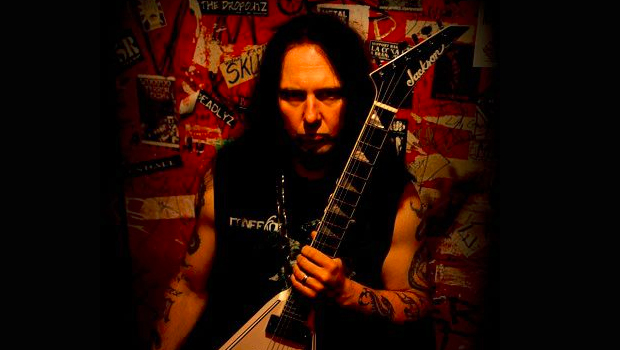Metal For Life: How to Build Power Chord Variations for Maximum Sonic Effect, Part 2

In this month’s column, I’d like to show you some simple and effective ways to make your metal rhythm guitar parts sound bigger, heavier and more powerful. These ideas are useful in many different ways, and I think you will find them applicable in live performance as well as when overdubbing and layering tracks.
Let’s start with a basic metal-type chord progression, using standard two-note root-fifth power chords, fretted on the fifth and fourth strings and played against an open low E pedal tone (FIGURE 1). I start with an E5 power chord, made up of the root note, E, and the fifth, B, followed by two palm-muted open low E notes. I then move down to C5, alternated against the open low E pedal in the same way, and wrap up the progression on B5 before returning to the I (one) chord, E5.

Now, how can we take a fairly standard rhythm part like this and make it sound bigger and more exciting? One effective way to do this is to take the two-note power chord and move either the root or the fifth to a different string, trying different combinations while listening closely to how these subtle differences can alter and fill out the sound.
An easy way to fatten up this rhythm part is to drop the fifth, B, down to the sixth string while keeping the E root note on the fifth string. As shown in FIGURE 2, I barre my index finger across the bottom two strings to sound each power chord in the progression, shifting my hand up and down the neck and lifting my finger off the strings to sound the open low E notes between the chord accents.

Already, this riff sounds a little heavier and more sinister, so we are on the right track. Now, let’s double the fifth by adding B, fourth string/ninth fret, to the root-fifth shape played in FIGURE 2. This new, three-note power chord–driven progression is shown in FIGURE 3.
Let’s continue this idea by stacking another root note onto the previous fifth-root-fifth power-chord stack, adding a high E, third string/ninth fret, which results in a four-note power-chord voicing. As shown in FIGURE 4, this simple progression now sounds much wider and bigger than it initially did, in FIGURE 1.

For our last example, I’d like to expand each power chord to a different type of four-note voicing. This next technique is used often by Dream Theater guitarist John Petrucci, and it involves stacking the ninth on top of each three-note power-chord voicing introduced in FIGURE 3. Applied to the first chord, E5, the result is the four-note Esus2 voicing that kicks off the rhythm part shown in FIGURE 5. When moved down to third and second position, the resulting chords are Csus2 and Bsus2, respectively.
All the latest guitar news, interviews, lessons, reviews, deals and more, direct to your inbox!
I think of these sus2 voicings as “progressive metal” chords, because, though they still sound very tight like a typical power chord, the inclusion of the ninth lends the chord a wider and more unusual flavor. They do require a bit of a stretch, however, so make sure your fret hand is warmed up before reaching for these types of chords, especially in the lower positions.
